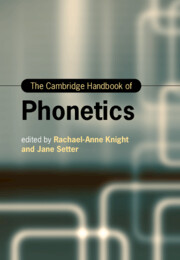Book contents
- The Cambridge Handbook of Phonetics
- Cambridge Handbooks in Language and Linguistics
- The Cambridge Handbook of Phonetics
- Copyright page
- Contents
- Figures
- Tables
- Contributors
- Introduction
- Section I Segmental Production
- Section II Prosodic Production
- Section III Measuring Speech
- Section IV Audition and Perception
- Section V Applications of Phonetics
- 20 Pedagogical Approaches
- 21 Pronunciation Teaching
- 22 Sociophonetics
- 23 Developmental Phonetics of Speech Production
- 24 Clinical Phonetics
- 25 Forensic Phonetics
- 26 The Phonetics of Talk in Interaction
- 27 The Phonetics/Phonology Interface
- Index
- References
25 - Forensic Phonetics
from Section V - Applications of Phonetics
Published online by Cambridge University Press: 11 November 2021
- The Cambridge Handbook of Phonetics
- Cambridge Handbooks in Language and Linguistics
- The Cambridge Handbook of Phonetics
- Copyright page
- Contents
- Figures
- Tables
- Contributors
- Introduction
- Section I Segmental Production
- Section II Prosodic Production
- Section III Measuring Speech
- Section IV Audition and Perception
- Section V Applications of Phonetics
- 20 Pedagogical Approaches
- 21 Pronunciation Teaching
- 22 Sociophonetics
- 23 Developmental Phonetics of Speech Production
- 24 Clinical Phonetics
- 25 Forensic Phonetics
- 26 The Phonetics of Talk in Interaction
- 27 The Phonetics/Phonology Interface
- Index
- References
Summary
This chapter introduces the application of phonetics to various legal situations involving speech. In these situations, the identity of a speaker is in question or the linguistic content is disputed. Forensic phonetics focuses on the differences between members of a speech community resulting from physiological differences as well as choices under the speaker’s control (whether conscious or not). While some of this idiosyncrasy is found at the phonological level, the most useful speaker-discriminatory information is often encoded in the fine phonetic detail. It is where such patterns show a good degree of within-speaker consistency and between-speaker difference that the examination of a particular phonetic feature becomes useful in forensic analysis. This chapter considers the place of analysis by ear (by both expert and naïve listeners), the quantitative phonetic analysis of the acoustic signal, as well as automatic methods of analysis. It also considers how best to arrive at a scientifically defensible probabilistic conclusion, and how such conclusions may be communicated in a legal context. Best practice for the teaching and learning of forensic phonetics is also discussed.
Keywords
- Type
- Chapter
- Information
- The Cambridge Handbook of Phonetics , pp. 631 - 656Publisher: Cambridge University PressPrint publication year: 2021
References
25.7 References
- 1
- Cited by



